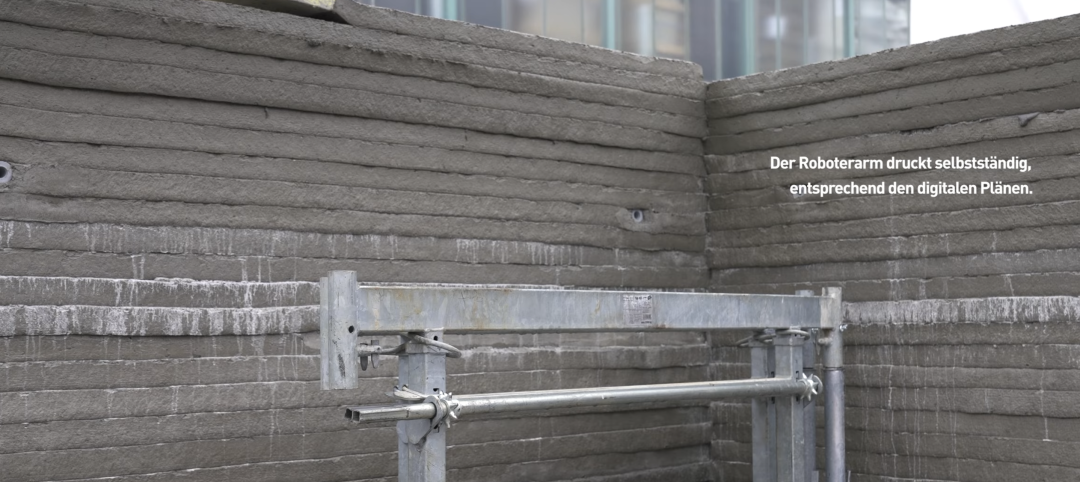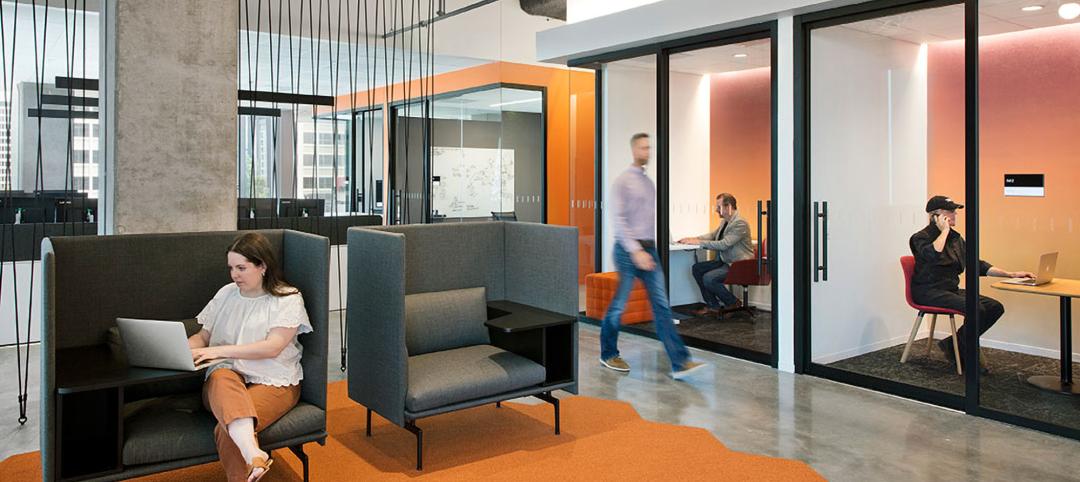When Kaiser Permanente opens its massive, one-million-sf Oakland Medical Center Replacement Project early next year, staff, patients, and families may notice something peculiar about the place. Open almost any door in the complex and they’ll find a stamp-size, red-and-white emblem affixed to the hinge side of the doorjamb. A closer look will reveal the logo of McCarthy Building Companies at the center of the label.
No, this isn’t a sly branding scheme by the project’s general contractor. It’s a quick response (QR) code created for that specific location in the building—for use by both the Building Team during construction and Kaiser Permanente’s facilities team throughout the life of the buildings.
The QR codes are a vital component of one the largest implementations to date of augmented reality (AR) technology in the U.S. construction industry. At any given time, a project superintendent, subcontractor, architect, facilities team member, or other field personnel can scan one of the QR codes throughout the campus with a smartphone or tablet computer and instantly immerse themselves in the up-to-date, as-built 3D BIM model or 3D laser scan of that space.
Augmented reality: 12 applications for design and construction professionals
Building Design+Construction reached out to AEC professionals who have studied and applied augmented reality and asked them to pinpoint applications that are ripe for the technology. Here’s what they had to offer. Read article.
Want to see what’s behind a wall? Simply scan the QR code on the doorjamb in the room, point the mobile device’s camera lens toward the wall, and voilà!, you have an x-ray view of the wall assembly. From that point in the model, you can navigate to other spaces in the facility while maintaining the AR session. You could, for instance, compare the behind-wall infrastructure of the room you’re in to that of the adjacent room. The QR codes serve as a marker to help team members quickly place themselves at a specific point in the model or 3D laser scan.
“The intent was to keep it as simple and easy as possible for the end users in field,” says Chris Pechacek, McCarthy’s Virtual Design and Construction Director (www.mccarthy.com). “They don’t have to be software gurus and know how navigate through the model, or start their AR session on the outside of the building and have to make their way into the building. It enables all users to instantly access the information they need, saving precious time and avoiding frustrations with traditional systems.”
The QR codes also provide the team with one-click access to important project documentation, including RFIs, change orders, warranties, 2D plans, submittals, equipment manuals, and markups. To deliver this information to the field, McCarthy’s IT team built a custom digital document dashboard, which connects all relevant project information using a 2D interface. The setup incorporates a collection of software apps, including Bluebeam Vu, BIMAnywhere, BIM 360 Glue, and Faro Webshare, to allow a range of document types to be quickly accessed and viewed on tablets and smart phones in the field.
To help field personnel quickly access 3D BIM models and other project documents for the Oakland Medical Center Replacement Project, general contractor McCarthy Building Companies placed hundreds of QR codes throughout the complex. Users simply scan one of the QR codes with a smartphone or tablet computer and instantly immerse themselves in the up-to-date, as-built 3D BIM model or 3D laser scan of that space. Photo: McCarthy Building Companies
Pechacek says there are huge advantages to implementing AR on the job site, especially for complex, legacy buildings like hospitals. Take change orders, for example. In long-running hospital construction projects, where technologies and processes may change multiple times during a three- to five-year project span, change orders can have a significant impact on the project schedule and budget.
“Say the client wants to change out a piece of equipment in a patient room,” says Pechacek. “Traditionally, the subs would have to open up the entire wall, clean it out, locate the hookups for the equipment, wait for inspection approval, and close and patch up the wall—a process that can take more than a day.”
Using AR, the team would be able to cut that timeframe down to hours, says Pechacek. “The laser scanning shows exact, as-built information, so you know precisely where the wall backing, pipes, boxes for the connections, med gas, etc., are located behind the wall or above the ceiling,” he says. “So instead of opening the entire wall, they can hole saw to the exact location of the pipe, connect it, and do a quick patch in about an hour.”
The same goes for operations and maintenance applications. Not having to take a patient room out of commission to perform maintenance, repairs, or upgrades offers substantial savings for the healthcare system client. Also, all major building systems will have their own QR code, for instant access to manuals, warranties, preventive maintenance schedules, and work histories.
“For them to be able to walk into a room with a tablet and see exactly where everything is or access information on a piece of equipment without having to run back to their computer, that’s a huge benefit,” says Pechacek.
The key to McCarthy’s AR implementation is capturing the as-built environment at several stages during construction using 3D laser scanning. The McCarthy team conducted comprehensive scanning sessions during the final-inspection stage, when all building systems and infrastructure were installed and the team was waiting for final signoff to close up the walls and ceilings.
“Most AEC firms will laser scan existing conditions for use for design development on a renovation project,” he says. “We’re doing it during the course of construction, creating as-builts as we go, and using that as a component within our change-management process. This has allowed us to mitigate the impacts of changes, and has helped to keep us on schedule and within budget. For such a large project, it’s a substantial feat to be able to pull this off.”
Eventually, several hundred QR codes will be placed throughout the complex, on the doorjambs of most rooms, as well as on key building and medical equipment and systems.
AR comes to the AEC sector
Since the mid-1960s, computer scientists and inventors have tested the concept of overlaying digital information onto the real world, first with bulky, head-mounted displays and later with sleek, portable monitors. But it wasn’t until Apple popularized the iPad in early 2010 that AR would become financially feasible for general construction applications. With the meteoric rise of tablet computing came the boom in tablet apps—the combination of which provided AEC professionals with a relatively low-cost, consumer-level hardware/software solution for bringing AR to the field. Almost overnight, any design or construction professional with $500 and basic knowledge of AR had a method for bringing his or her 3D models to life on the job site.
Today, there are nearly a dozen AR-related apps available on iTunes or Google Play, and more are in the works, according to Dace Campbell, AIA, LEED AP, Customer Success Manager with Autodesk, who has been developing, applying, and promoting AR in the AEC industry for years (Campbell authored an article on the topic for BD+C in February 2012).
“Products like Google Glass have made augmented reality more of a household term,” says Campbell, who was named a BD+C “40 Under 40” honoree in 2011. While real-world AR applications are still rare in the construction industry, Campbell sees the adoption rate growing as the next generation of tools is developed and AEC professionals become more familiar with the technology.
Campbell says the next iteration of AR software apps will offer better integration with existing BIM workflows, allowing field users to access, review, and update the model in real time.
“The current state of apps requires you to divorce away from your standard tools, do a one-off exploration with consumer-level AR tools, and then you’re left with a branch in the workflow that’s a dead end,” says Campbell. “If you don’t have software that works with your everyday tools, AR becomes an expensive, specialized case. AR shouldn’t be a standalone app. Soon, the best BIM apps will likely have an AR mode.”
Another obstacle is the sheer amount of data in models. Many consumer-level AR apps and tablet computers have a difficult time handling rich data sets, especially for large projects like stadiums and hospitals. Some teams have had to simplify their data sets in order to implement AR, which goes back to the BIM-workflow disconnect problem.
Campbell also sees accuracy problems related to AR hardware and software. “AR is all about the co-location of virtual and physical space, or virtual data onto physical space, no matter what the display device is,” he says. “Through that you have to co-locate that data correctly in the space, which comes down to position tracking, orientation tracking, and scale. AEC models are built full-scale, and orientation tracking is relatively easy, especially with a tablet’s gyroscope. Position tracking is the real challenge—there’s no consumer-level, out-of-the box solution for accurate position tracking today. We have GPS, which works with line-of-sight applications outdoors, but that’s only accurate to the nearest meter.”
Finally, in the not-too-distant future, teams won’t have to use QR codes or markers on the job site, because the AR application will recognize precisely where the mobile device is located on the site and will automatically orient and match the model view.
“That’s the Holy Grail, and I think we’re getting there,” says Campbell. “In the meantime we have to work with markers to get reasonably accurate tracking.
“A number of software companies have been hard at work to come up with the next generation of tools that address the problems that people have encountered,” he says. “I’m optimistic that we’re less than 18 months away from some big developments.”
Related Stories
Laboratories | May 24, 2024
The Department of Energy breaks ground on the Princeton Plasma Innovation Center
In Princeton, N.J., the U.S. Department of Energy’s Princeton Plasma Physics Laboratory (PPPL) has broken ground on the Princeton Plasma Innovation Center (PPIC), a state-of-the-art office and laboratory building. Designed and constructed by SmithGroup, the $109.7 million facility will provide space for research supporting PPPL’s expanded mission into microelectronics, quantum sensors and devices, and sustainability sciences.
MFPRO+ News | May 24, 2024
Austin, Texas, outlaws windowless bedrooms
Austin, Texas will no longer allow developers to build windowless bedrooms. For at least two decades, the city had permitted developers to build thousands of windowless bedrooms.
Resiliency | May 24, 2024
As temperatures underground rise, so do risks to commercial buildings
Heat created by underground structures is increasing the risk of damage to buildings, recent studies have found. Basements, train tunnels, sewers, and other underground systems are making the ground around them warmer, which causes soil, sand, clay and silt to shift, settle, contract, and expand.
Sports and Recreational Facilities | May 23, 2024
The Cincinnati Open will undergo a campus-wide renovation ahead of the expanded 2025 tournament
One of the longest-running tennis tournaments in the country, the Cincinnati Open will add a 2,000-seat stadium, new courts and player center, and more greenspace to create a park-like atmosphere.
Mass Timber | May 22, 2024
3 mass timber architecture innovations
As mass timber construction evolves from the first decade of projects, we're finding an increasing variety of mass timber solutions. Here are three primary examples.
MFPRO+ News | May 21, 2024
Massachusetts governor launches advocacy group to push for more housing
Massachusetts’ Gov. Maura Healey and Lt. Gov. Kim Driscoll have taken the unusual step of setting up a nonprofit to advocate for pro-housing efforts at the local level. One Commonwealth Inc., will work to provide political and financial support for local housing initiatives, a key pillar of the governor’s agenda.
Building Tech | May 21, 2024
In a world first, load-bearing concrete walls built with a 3D printer
A Germany-based construction engineering company says it has constructed the world’s first load-bearing concrete walls built with a 3D printer. Züblin built a new warehouse from a single 3D print for Strabag Baumaschinentechnik International in Stuttgart, Germany using a Putzmeister 3D printer.
MFPRO+ News | May 21, 2024
Baker Barrios Architects announces new leadership roles for multifamily, healthcare design
Baker Barrios Architects announced two new additions to its leadership: Chris Powers, RA, AIA, NCARB, EDAC, as Associate Principal and Director (Healthcare); and Mark Kluemper, AIA, NCARB, as Associate Principal and Technical Director (Multifamily).
MFPRO+ News | May 20, 2024
Florida condo market roiled by structural safety standards law
A Florida law enacted after the Surfside condo tower collapse is causing turmoil in the condominium market. The law, which requires buildings to meet certain structural safety standards, is forcing condo associations to assess hefty fees to make repairs on older properties. In some cases, the cost per unit runs into six figures.
Office Buildings | May 20, 2024
10 spaces that are no longer optional to create a great workplace
Amenities are no longer optional. The new role of the office is not only a place to get work done, but to provide a mix of work experiences for employees.


















